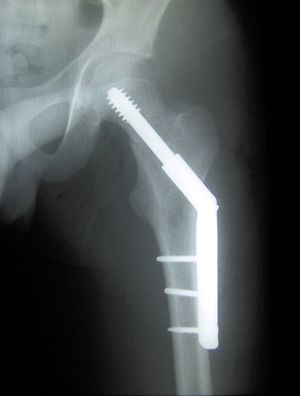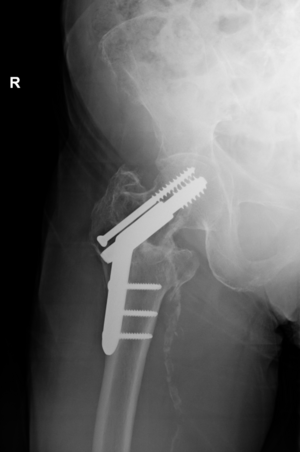Dynamic Hip Screw - DHS: Difference between revisions
(weight bearing status) |
No edit summary |
||
| (30 intermediate revisions by 3 users not shown) | |||
| Line 1: | Line 1: | ||
<div class="editorbox"> '''Original Editor '''- [[User: | <div class="editorbox"> '''Original Editor '''- [[User:Rhiannon Clement|Rhiannon Clement]]<br> | ||
'''Top Contributors''' - {{Special:Contributors/{{FULLPAGENAME}}}}</div> | '''Top Contributors''' - {{Special:Contributors/{{FULLPAGENAME}}}}</div> | ||
== | == Introduction == | ||
[[File:DHS.jpg|thumb|Xray DHS]] | |||
The dynamic [[Hip Anatomy|hip]] screw (DHS), a [[Femur|femoral]] head-sparing orthopaedic device, is used to treat [[Femoral Neck Fractures|femoral neck fractures]]. Alternately referred to as a pin and plate. | |||
# Femoral neck fractures that are undisplaced ([[Femoral Neck Fractures, Garden Classification|Garden]] I and II fractures) can be treated with head-preserving surgery and internal fixation. | |||
# In fractures with a high risk of [[Avascular necrosis of the femoral head|femoral head avascular necrosis]] ([[Femoral Neck Fractures, Garden Classification|Garden]] III and VI fractures), femoral head resection and [[Partial Hip Replacement|hip hemiarthroplasty]] is favoured. | |||
Note: DHS is a trade name for the Synthes company, being one type of sliding hip screw. There are various types of sliding hip screws produced by various implant companies. <ref name=":2">Radiopedia DHS Available:https://radiopaedia.org/articles/dynamic-hip-screw (accessed 14.12.2022)</ref> | |||
== Technique == | |||
== | After reduction, the fracture is internally fixed by application a large lag screw through the neck, this is held laterally by a lateral femoral plate. The DHS can slide in the plate along the longitudinal axis of the femoral neck, permitting compression of the fracture hence aiding healing. If sliding takes place, the lateral end of the lag screw may project laterally from the plate. | ||
# | Watch this 10 minute video on the technique.{{#ev:youtube|A3x0GmAHcKY|}} | ||
== History == | |||
[[File:Dynamic-hip-screw-sliding.png|thumb|Previous lag screw, has slid, indicating # compression. ]] | |||
Prior to the use of DHS sliding screws, angled blade plates were used<ref name=":0">Singh A.P. ''Dynamic Hip Screw Or Sliding Hip Screw''. [online] Available at: <<nowiki>http://www.boneandspine.com/dynamic-hip-screw/</nowiki>> [Accessed 19 September 2020].</ref>. These fixed plates matched the angle of the femural head. These plates had a number of complications, including failure to purchase, requiring frequent [[Osteotomy|osteotomies]]. They also did not allow any compression across the fracture site, leading to stress failures and frequent non-union<ref name=":0" />. Therefore, the DHS, with sliding barrel, was created to allow controlled compression across the fracture site. This is important for [https://physio-pedia.com/Bone_Healing#sts=Stages%20of%20Indirect%20Healing?utm_source=physiopedia&utm_medium=search&utm_campaign=ongoing_internal bone healing]. | |||
NICE Guidelines recommends: Use extramedullary implants such as a sliding hip screw in preference to an intramedullary nail in patients with trochanteric fractures above and including the lesser trochanter (AO classification types A1 and A2)<ref name=":1">NICE ''Hip Fracture: Management'' <available from: https://www.nice.org.uk/guidance/cg124/chapter/Recommendations#analgesia> [accessed 19/9/20]</ref>. | |||
== Complications == | |||
See also [[Fracture Complications|fracture complications]] | |||
* Infection | |||
* Haematoma | |||
* Non-union or malunion | |||
* Implant complication, e.g. screw or plate fracture (2% 2) | |||
* [[Avascular Necrosis|Avascular necrosis]]<ref name=":2" /> | |||
== Physiotherapy Interventions == | |||
See [[Femoral Neck Hip Fracture]] | |||
== References == | == References == | ||
<references /> | <references /> | ||
[[Category:Hip]] | |||
[[Category:Hip - Interventions]] | |||
[[Category:Fractures]] | |||
[[Category:Orthopaedic Surgical Procedures]] | |||
Latest revision as of 02:18, 16 December 2022
Top Contributors - Rhiannon Clement, Lucinda hampton and Kim Jackson
Introduction[edit | edit source]
The dynamic hip screw (DHS), a femoral head-sparing orthopaedic device, is used to treat femoral neck fractures. Alternately referred to as a pin and plate.
- Femoral neck fractures that are undisplaced (Garden I and II fractures) can be treated with head-preserving surgery and internal fixation.
- In fractures with a high risk of femoral head avascular necrosis (Garden III and VI fractures), femoral head resection and hip hemiarthroplasty is favoured.
Note: DHS is a trade name for the Synthes company, being one type of sliding hip screw. There are various types of sliding hip screws produced by various implant companies. [1]
Technique[edit | edit source]
After reduction, the fracture is internally fixed by application a large lag screw through the neck, this is held laterally by a lateral femoral plate. The DHS can slide in the plate along the longitudinal axis of the femoral neck, permitting compression of the fracture hence aiding healing. If sliding takes place, the lateral end of the lag screw may project laterally from the plate.
Watch this 10 minute video on the technique.
History[edit | edit source]
Prior to the use of DHS sliding screws, angled blade plates were used[2]. These fixed plates matched the angle of the femural head. These plates had a number of complications, including failure to purchase, requiring frequent osteotomies. They also did not allow any compression across the fracture site, leading to stress failures and frequent non-union[2]. Therefore, the DHS, with sliding barrel, was created to allow controlled compression across the fracture site. This is important for bone healing.
NICE Guidelines recommends: Use extramedullary implants such as a sliding hip screw in preference to an intramedullary nail in patients with trochanteric fractures above and including the lesser trochanter (AO classification types A1 and A2)[3].
Complications[edit | edit source]
See also fracture complications
- Infection
- Haematoma
- Non-union or malunion
- Implant complication, e.g. screw or plate fracture (2% 2)
- Avascular necrosis[1]
Physiotherapy Interventions[edit | edit source]
References[edit | edit source]
- ↑ 1.0 1.1 Radiopedia DHS Available:https://radiopaedia.org/articles/dynamic-hip-screw (accessed 14.12.2022)
- ↑ 2.0 2.1 Singh A.P. Dynamic Hip Screw Or Sliding Hip Screw. [online] Available at: <http://www.boneandspine.com/dynamic-hip-screw/> [Accessed 19 September 2020].
- ↑ NICE Hip Fracture: Management <available from: https://www.nice.org.uk/guidance/cg124/chapter/Recommendations#analgesia> [accessed 19/9/20]








